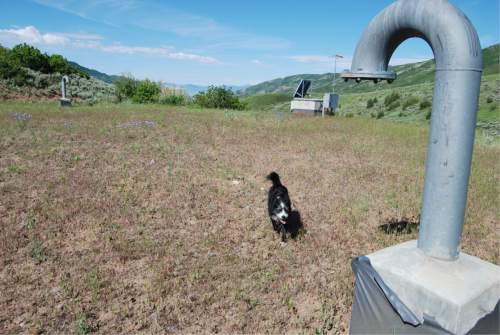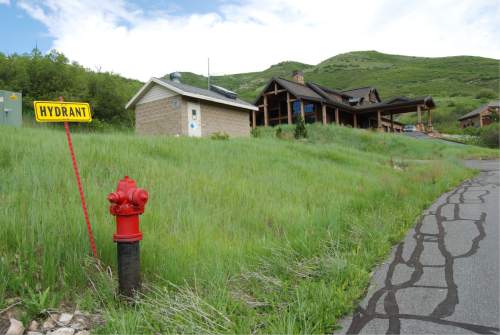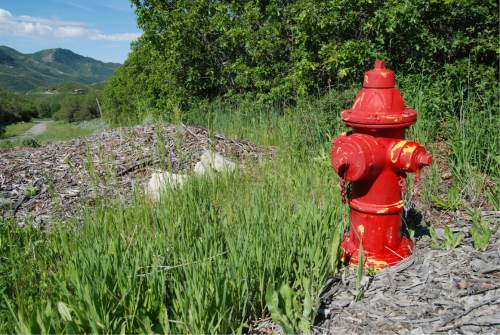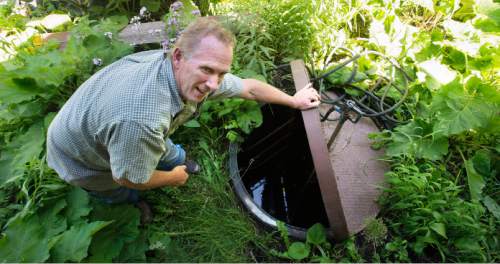This is an archived article that was published on sltrib.com in 2015, and information in the article may be outdated. It is provided only for personal research purposes and may not be reprinted.
Emigration Canyon • On a foothill divide above Salt Lake City sits a reservoir 96 feet across, covered with construction debris and dirt sprouting flax and cheatgrass.
The concrete cistern hidden among gambel oak and sagebrush was built a dozen years ago to provide a reliable water source for some of the Wasatch Mountains' most desirable real estate.
But it also is fueling a long-simmering controversy in the neighborhood.
A lawsuit filed last month in U.S. District Court alleges the Emigration Improvement District used subterfuge to obtain the federally backed loans needed to develop an extensive water system that includes the tank, a network of water lines, hydrants and wells.
Some residents suspect the water tank is part of a larger plan to consolidate water rights and build even more homes in the narrow canyon 1,500 people call home.
The reservoir allegedly holds twice the 1 million gallons specified in loan documents.
It was supposed to rise above grade on a flat spot in a saddle owned by Salt Lake City. Instead, a lawsuit filed by canyon resident Mark Tracy alleges the district built it into the side of a hill a short distance to the south, on land owned by Steve Creamer, the former CEO of EnergySolutions, who owns large tracts of land in the canyon. The tank can be reached only by a gated road through Creamer's property at the head of Brigham Canyon.
Tracy contends district managers have colluded with Creamer and two other owners of undeveloped property to misuse bonds to build the water system in a scheme the suit calls "one of the most perpetual and lucrative water grabs in the history of the state of Utah."
The losers, according to the suit, are residents who occupy older, less luxurious properties along the canyon floor and Emigration Creek, whose flows could be cut in half to satisfy the needs of larger homes built in the hills above the stream.
"The infrastructure appears to be built not to supply existing owners, but for the benefit of owners of larger parcels who would love to develop, but they need the water to do so," said Tracy's lawyer, Scot Boyd.
As proof, Boyd points to 8-inch supply lines installed at huge expense to serve areas with only a handful of homes.
"Why is there acreage up there with fire hydrants all over the place when they say they are not set out to develop those areas?" Boyd asked.
District officials dismiss the allegations as politically inspired fantasy.
"The majority of the accusations are completely false and inaccurate, and the statements that are correct are used to support absurd conspiracy-theory conclusions," said the district's lawyer, Jeremy Cook.
Boyd said Tracy, a vocal critic of the district, is not alone among canyon residents who feel the district has gone too far. But Tracy, who lives in Pinecrest at Emigration Creek's headwaters, was the one who agreed to put his name on the suit, which is being funded by others who wish to remain anonymous, Boyd said.
—
"We don't need your water" • Named for the Mormon pioneers who hauled handcarts through on their way to the Salt Lake Valley starting in 1847, Emigration Canyon is a coveted ZIP code among those who enjoy a natural setting but need easy access to the city.
The new legal fight reflects mounting tensions between affluent residents on newer properties, such as those in the Emigration Oaks neighborhood served by the district's water system, and those who live in creekside "slums" along the canyon road.
Longtime canyon residents have relied on private wells that tap old water rights. But many say the district has pressured them into forfeiting their "senior," and more valuable, water rights and abandoning their wells to hook into the water system at great expense.
Residents Blake Karrington, Jamie White and Kennard Machol all have invested in functioning wells. But the Emigration homeowners say the district's retired general manager, Fred Smolka, used high-pressure tactics to encourage them to sign "standby" agreements that obligate them to pay monthly fees just to maintain the option of joining the water system at a later date.
"We have a wonderful well on one of oldest properties in the canyon," Machol said. "You want us to leave a perfectly good well. It would cost us tens of thousands of dollars. We don't need your water."
Improvement district general manager Erik Hawkes maintains the district doesn't need to consolidate individual old-timers' water rights.
The improvement district, which formed in 1968, holds the canyon's most senior water right, dating back to 1872. That share of water was initially associated with a long-forgotten ditch company that once watered canyon orchards.
Hawkes rejects reports that homeowners were forced to relinquish their water rights. Still, he acknowledges that those who joined the water system were required to pay $6,000 if they chose to hang on to their water right.
In the end, the district manager says, Emigration homeowners will benefit from the district's building projects.
"You are part of this system even if you didn't want to be," Hawkes said. "There is benefit to having hydrants and a secondary water source to your property. There is value there. It's equity in their property."
Hawkes believes the suit's allegations "have been fabricated to demean the district and some of its community members" before November's election, when two district board seats are up.
Tracy's suit names the district and two of its contractors, Carollo Engineers and Aqua Environmental Services, as defendants, along with Smolka and Hawkes; trustees Michael Hughes, Mark Stevens and David Bradford; and former trustee Lynn Hales, who chairs the district's engineering committee.
—
Water pressure • Tracy has argued in open letters to canyon residents that the district's projects provide little benefit to most property owners who nonetheless are required to support the district through property taxes and numerous assessments of dubious legitimacy. He claims district officials, particularly Smolka, engage in nepotism by hiring family members, are overpaid, and rig board elections — all of which water managers deny.
But Hawkes says Tracy "never addressed anything with the district. He has never participated in any of the [monthly] meetings. I don't know where he gets his information."
District board members, he said, "have done things by the rules and followed the guidelines. Water has always been a big thing here."
The district operates a water system with four wells, two tanks with a total capacity of 1.3 million gallons, water lines that cover 70 percent of the canyon's populated area and fire hydrants within 250 feet of all properties served by these lines.
The system serves 273 homes and can serve another 253, should property owners decide to hook up.
"These improvements represent millions of dollars of engineering and infrastructure development and have benefited every canyon resident in both increased property values and decreased insurance premiums," district leaders wrote to residents last year in response to Tracy's criticisms.
"We also provide water to residents whose wells have run dry or otherwise become unusable."
Tracy's lawsuit was filed under seal May 1 in federal court and was unsealed only last week.
The canyon property owner brought the suit under the federal False Claims Act, which allows private citizens to sue on behalf of the federal government over alleged fraudulent handling of federal funds.
In the Emigration case, Tracy contends district officers secured $6.3 million in federally backed bonds under the pretense of developing water solely for existing homes. The loans were a way to work around the will of district residents, who voted down a bond initiative to build a water system in 1995, the suit alleges.
District officials started applying in 2001 for a series of federal loans administered by the Utah Division of Drinking Water. To qualify, the district had to sign up a certain number of property owners to commit to joining the water system in the future.
So Smolka went door to door.
According to Hawkes, some residents were in a desperate situation with water and eagerly joined. Others balked.
As residents started abandoning their wells, remaining wells have gotten more productive, so the holdouts have less incentive to join the water system, he said. In the meantime, the district still had to stub the main water lines and install water meters to serve them should their wells someday fail.
Jamie White, who is running for a seat on the board, doesn't buy that explanation.
"I don't like to see people pushed around," said White, a self-employed bicycle designer. "It's kind of extortion. They told me I would have to connect.
"If my well dried up, it would be so the rich people in the Oaks can water their golf greens," he added. "I could take them to court, but a court case would cost 50 grand and they would wear me down financially."
—
Zoned for conspiracy • Tracy's suit claims the ulterior motive behind the water system is to make water available for large tracts of unplatted land, much of it held by Creamer, who lives in a large home on Brigham Fork Circle at the top of Emigration Oaks.
One of the hydrants Boyd criticizes is on Creamer's property, below the big cistern but far from any structure.
No one answered the phone at the Creamer residence this week.
County zoning currently allows a single home per 20 acres on the remaining undeveloped tracts.
However, the Community Preservation Act passed this year gives townships greater autonomy.
Tracy contends the law soon will enable the Emigration township to reset zoning, potentially at much higher density.
The lawsuit projects the value of 900 acres held by Creamer and two other property owners could balloon to $500 million if the land gets water and zoning favorable for development.
District leaders say that's just a conspiracy theory. That dollar amount exceeds the current value of all the canyon's private land, and the owners in question have shown no interest in developing, according to Cook.
"I can't imagine the township could pull off their own zoning," Hawkes said. "They would rely on the county as they have the past. We don't have the revenue and commercial [properties] to support that."
Currently, there are about 600 homes built in the canyon, with another 100 undeveloped lots. The only commercial development in the canyon is clustered around Ruth's Diner.













